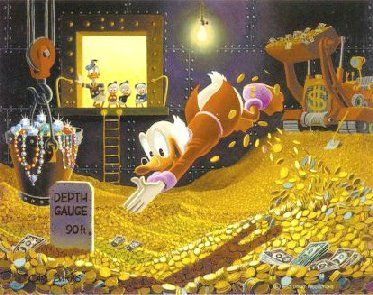2008 – A year in funnybooks

I actually discovered the group blog The Savage Critics because of Brian Hibbs interesting column Tilting at Windmills. There are all kinds of good blogs from the “through-the-looking-glass” world of comic-book retail – but Brian has a penchant for distilling all kinds of nit-picky retail data into a comprehensible fashion. He recently posted two quick lists of his store’s 2008 top-sellers (one for “books” and one for “comics” (“books” primarily refers to trade paperbacks and other collections not, say, prose – and “comics” refers to single-issue “floppies”… more or less).
Something fascinating struck me from Brian’s posts though. Digging through his “books” lists, I own (in some format or another) over 52% of the top 100 items from the “books” list… yet over on the “comics” list, I own less than 16% (and if you remove “DC Universe Zero” and “Trinity #1” (which I got for free from my local shop), and a couple “Astonishing X-Men” (which I bought by mistake, although ended up enjoying) that’s less than 10% I actually intentionally shelled out money for.
That in and of itself doesn’t mean a lot – there’s a lot of “greatest hits” material on the “books list” and I have been buying trades for… a while. For example, I have a copy of “Sam & Max: Surfing the Highway” (tied for #30 in sales on Brian’s list) from ’94 or so, so it’s far more likely I’d already own something on the “books” list. However, I was surprised on how much less interesting I found the “comics” list overall. I suppose this could boil down to the fact that fewer, more popular, properties are going to be represented on that list (also more Marvel, and I’ve always been more of a DC fan)… but it’s interesting that there doesn’t seem to be any representation of the smaller-press material that at least sprinkles the “books” list. Not only that though, but there’s very little crossover between the two lists (outside of “Buffy”, which should really be it’s own category entirely as it has it’s own, insular, market). For example, Brian’s best selling series for trades this year was clearly “Y The Last Man” (all 10 trades show up in his top 25 sellers, including the 2nd, 3rd, and 4th highest seller overall) – but not a single issue broke the “comics” list (heck I don’t think there was a single Vertigo title in the “comics” list at all). Conversely, Marvel has almost half of the entries on the “comics” list, but only one sole entry on the “books” list?
Given that Brian starts his post with “Books” generally being 51% of his total sales, and “Comics” being “41%” (I presume the remaining 10% is action figures, games, trading cards, &etc…) this clearly would suggest a picture of a weird dichotomy of customers who are only buying certain material in certain formats. While I’d expect that would be the case per customer (for example I buy “Fables” as floppies, just because I started to buy the series from issue #1 – I bought “Y” as trades for the inverse reason) I’m surprised that those format decisions seem to have some kind of uniformity across the market.
I haven’t given a lot of credence to those decrying the “death of the floppy (single-issue)” – but it seems increasingly true that sales in that sector risk ghettoizing into mainstream super-hero fare while the trade market seems to have a little more genre depth (yes I’m dealing with a very limited sample, and kind of comparing apples and oranges here, since it’s not really a dollar-to-dollar comparison… however Brian’s a good retailer so I don’t think it’s wrong to assume he’s far outside the ballpark of a representative sample and the “price per series” between floppies and trades is close enough for a rough comparison).
I know that if I was told, based on those two lists, that I could only buy material in the future in one of the two distributor categories – It wouldn’t even be close… something that would have surprised me prior to looking at Brian’s data.
Somehow I think I should be able to tie this better into my vague underlying gut-feeling that if the comics companies could really figure out a coherent digital-distribution platform to act as “interim trades” they (and even traditional retailers) could potentially be a lot more profitable… but that’s a rant for a different day.


